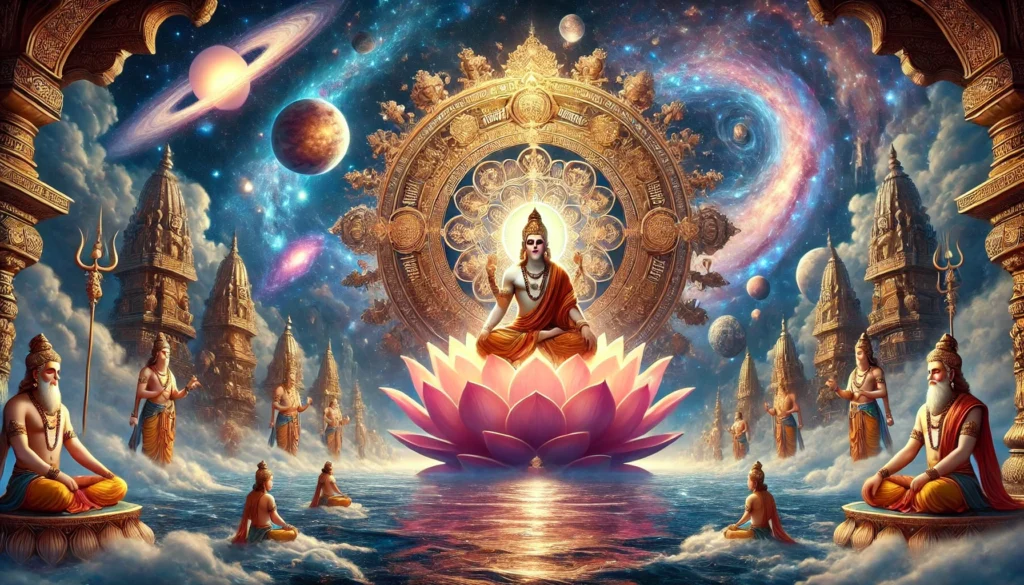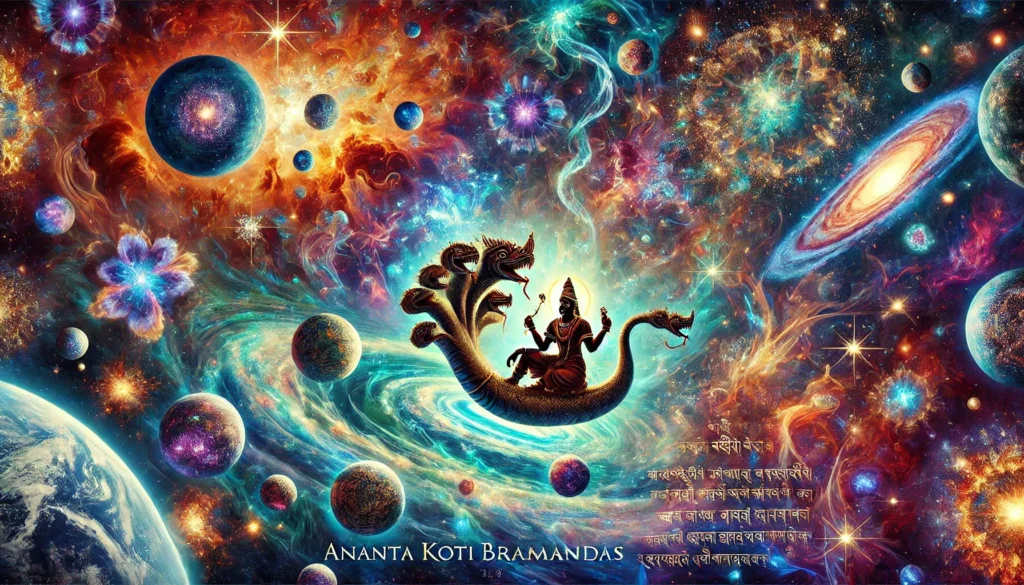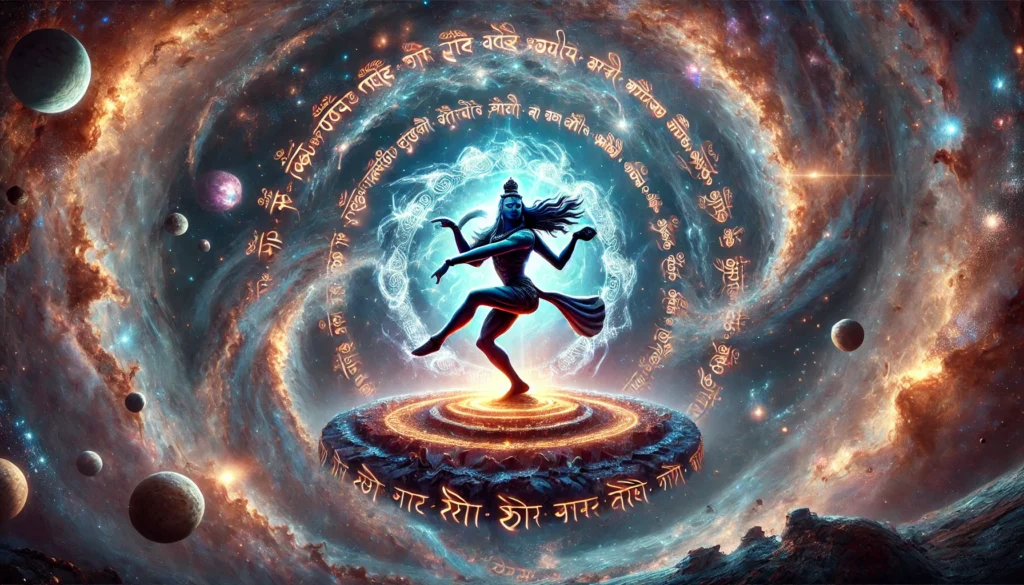Time travel—a concept that has captivated human imagination through science fiction and scientific exploration—is not just a modern-day fascination. Ancient Indian scriptures, particularly the Vedas and Puranas, are replete with references that challenge our understanding of time. These texts offer profound insights into the cyclical nature of time, temporal anomalies, and cosmic scales that align remarkably with modern physics theories like Einstein’s relativity, time dilation, and even the multiverse.
Could the seers of ancient India have understood these complex phenomena long before modern science? This article dives into time travel in Vedas, exploring parallels between mythology and modern physics, and revisiting stories that transcend time.

Table of Contents
- Vedic Understanding of Time
- Time Travel in Mythological Stories
- King Kakudmi and Revati
- Sage Narada’s Travels
- Eternal Curses: Ashwatthama and Trishanku
- Parallels Between Vedic Time and Modern Science
- Vimanas: Celestial Vehicles and Time Manipulation
- Modern Science Meets Vedic Wisdom
- Conclusion
- FAQs
Vedic Understanding of Time
The foundation of time in Vedic cosmology is unlike the linear perspective of Western thought. The ancient Indian view is rooted in cyclicality and relativity, echoing ideas we associate with modern astrophysics.
Cyclical Nature of Time
At the heart of Vedic cosmology is the Kalachakra, or “Wheel of Time,” which governs everything in existence. Time in Hindu cosmology is cyclical, repeating across unimaginably vast epochs.
The Four Yugas
The cycle begins with the four Yugas:
- Satya Yuga: The golden age of truth, lasting 1,728,000 years.
- Treta Yuga: The silver age of virtue, lasting 1,296,000 years.
- Dvapara Yuga: The bronze age of diminishing morality, lasting 864,000 years.
- Kali Yuga: The iron age of darkness, lasting 432,000 years (the age we live in now).
The four Yugas combined form a Mahayuga, lasting 4.32 million years. A thousand Mahayugas constitute one day of Brahma, equating to 4.32 billion Earth years.
Sanskrit Reference:
“युगसहस्रयोजनं तं तु ब्रह्मणः दिवः।”
(A thousand Yugas together constitute one day of Brahma.)
The Vishnu Purana elaborates on this staggering scale, describing how the cycles of creation and destruction are embedded within Brahma’s days and nights. Such immense timelines eerily parallel modern theories of cosmic evolution.
Time Travel in Mythological Stories
The ancient Indian epics and Puranas offer numerous stories that reflect an advanced understanding of time’s fluidity. These narratives, rich in metaphors and spiritual depth, often suggest the ability to traverse or manipulate time.
1. King Kakudmi and Revati: The Original Time Travelers

One of the most compelling time-travel stories comes from the Vishnu Purana.
- The Tale: King Kakudmi, a wise and benevolent ruler, sought a suitable husband for his daughter, Revati. He decided to consult Lord Brahma directly, journeying to Brahmaloka (the celestial abode of Brahma).
While in Brahmaloka, Kakudmi waited briefly as Brahma listened to a musical performance. Upon his return to Earth, he discovered that 27 Yugas had passed—millions of years by earthly reckoning. His kingdom was gone, and the world had drastically changed.
- Scientific Parallels: This story reflects the concept of time dilation in Einstein’s theory of relativity, where time moves slower in higher gravitational fields or at near-light speeds. Kakudmi’s brief visit to Brahmaloka aligns with how time would pass differently across varying space-time fields.
2. Sage Narada’s Travels: Across Realms and Time
Sage Narada, one of Hindu mythology’s most enigmatic characters, is known for his ability to move seamlessly between the mortal world, celestial realms, and even Brahmaloka.
- Temporal Differences: Narada’s travels often highlight the non-linear flow of time across realms. For instance, a single day in Brahmaloka could equate to years or centuries on Earth.
- Implication: His journeys suggest the possibility of interdimensional travel, akin to traversing parallel universes or experiencing time at different rates in separate gravitational fields.
3. Eternal Curses: Ashwatthama and Trishanku
In the Mahabharata, Ashwatthama, cursed by Krishna for his deeds in the Kurukshetra war, is doomed to eternal wandering.
- Temporal Stasis: Ashwatthama’s immortality and inability to die echo a state of temporal suspension, where he remains ageless while time moves forward for others.
Another fascinating story is that of Trishanku, a king who attempted to ascend to heaven in his mortal form. Rejected by the gods, he was suspended between Earth and heaven, trapped in a liminal state—a metaphorical representation of being frozen in time and space.
Parallels Between Vedic Time and Modern Science

The philosophical depth of Vedic texts reveals striking similarities with modern physics.
1. Time Dilation in Brahma’s Time
Einstein’s theory of relativity explains that time moves slower in strong gravitational fields or at high velocities.
Parallel in Hindu Cosmology:
- The concept of Brahma’s day, lasting billions of years by earthly standards, mirrors time dilation.
- Kakudmi’s story provides an intuitive understanding of how time flows differently across realms.
2. Multiverse in Hinduism
The Vedic idea of Ananta Koti Brahmandas (infinite universes) aligns with the modern scientific hypothesis of a multiverse.
- Sanskrit Verse:
“कालः कल्पतरुं भजते”
(Time nurtures infinite creations.) - The Vishnu Purana describes the simultaneous existence of countless universes, each with its own cycles of creation and dissolution, much like the parallel universe concept in quantum physics.
3. Quantum Entanglement and Non-Locality
Hindu philosophy often describes events where actions in one realm affect another instantaneously.
- Narada’s Travels: His ability to traverse realms and influence events reflects a non-local connection, akin to quantum entanglement, where particles remain interconnected across distances.
Vimanas: Celestial Vehicles and Time Manipulation
Ancient texts like the Vimana Shastra describe Vimanas—flying vehicles that could traverse vast distances and realms.
Advanced Technology in Ancient India
- Descriptions: Vimanas were said to move using anti-gravity mechanisms, generating propulsion through sound or solar energy.
- Speculation: Could these be ancient technologies capable of bending space-time, allowing travelers to experience time differently?
Scientific Parallels
If Vimanas could achieve near-light speeds, they would create time dilation, where passengers would age slower than those left behind—a concept foundational to time travel in science.

Modern Science Meets Vedic Wisdom
Modern discoveries often echo concepts embedded in Vedic cosmology.
1. Time Dilation and Yuga Cycles
The cyclical nature of Yugas reflects time dilation at a cosmic scale, where vast epochs align with universal expansion and contraction theories.
2. Multiverse Theories
The description of infinite universes in the Vishnu Purana mirrors the multiverse hypothesis, where universes coexist and interact within a larger cosmic framework.
3. Non-Linear Time
Quantum theories challenge the linearity of time, resonating with the Vedic understanding of cyclical and fluid time.
Conclusion
Ancient Indian seers, through their profound insights, glimpsed truths about time, space, and the cosmos that modern science is only beginning to understand. From cyclical Yugas and celestial timelines to advanced technologies like Vimanas, their knowledge bridges the spiritual and the scientific.
Could these ancient texts hold the key to unlocking the universe’s greatest mysteries?
FAQs
1. What is time travel in Vedic texts?
Time travel in Vedas refers to temporal anomalies, such as Kakudmi’s visit to Brahma and Sage Narada’s realm-crossing journeys.
2. How do Yugas explain cyclical time?
Yugas represent repeating cycles of time, each reflecting stages of moral and cosmic evolution, reinforcing the cyclical nature of existence.
3. What is the multiverse concept in Hinduism?
The idea of Ananta Koti Brahmandas suggests infinite universes coexisting, aligning with the multiverse theory in quantum physics.
4. Are Vimanas related to time travel?
Speculatively, Vimanas could manipulate space-time, creating time discrepancies similar to those predicted by Einstein’s relativity.
